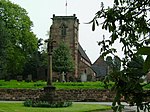Standon Bridge railway station
Disused railway stations in StaffordshireFormer London and North Western Railway stationsPages with no open date in Infobox stationRailway stations in Great Britain closed in 1952Railway stations in Great Britain opened in 1837 ... and 1 more
Use British English from December 2017
Standon Bridge railway station was a railway station in Standon, approximately 4 miles (6.4 km) west of Stone, Staffordshire. The station closed on 4 February 1952, the same day as Whitmore railway station 4 miles further north. The station is close to Mill Meece Pumping Station, an early 20th-century preserved steam-powered water pumping station built by Staffordshire Potteries Waterworks Company. During installation of a second steam engine in 1926–27, parts were delivered to Standon Bridge railway station and transferred by horse and cart to the pumping station. The station is also near to Swynnerton Army training camp, a large former Royal Ordnance Factory.
Excerpt from the Wikipedia article Standon Bridge railway station (License: CC BY-SA 3.0, Authors).Standon Bridge railway station
Cranberry Marsh,
Geographical coordinates (GPS) Address Nearby Places Show on map
Geographical coordinates (GPS)
| Latitude | Longitude |
|---|---|
| N 52.9134 ° | E -2.2587 ° |
Address
Cranberry Marsh
Cranberry Marsh
ST21 6SE , Standon
England, United Kingdom
Open on Google Maps





